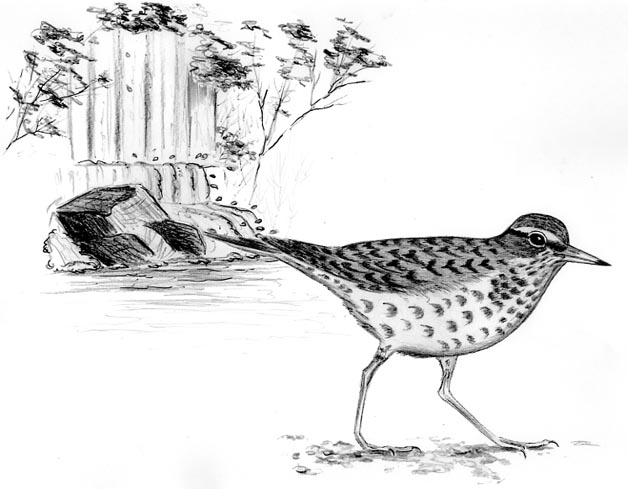
Dear Bird Folks,
Here in Upstate New York a friend of mine has created several man-made ponds on his property. These ponds attract a large assortment of birds and other wildlife. The identity of one of these birds has me stumped. (I’ve attached a photo.) It appears to be either a Sanderling or a Least Sandpiper. Please take a look at my photo and let me know what you think. Thank you very much,
– Winston, Attica, NY
You are very welcome, Winston,
Wow, “please” and “thank you very much.” You folks in Upstate New York sure are a polite bunch. I have several friends from your area and they are also extremely polite. Where does that come from? It must be the Canadian influence because it definitely doesn’t come from certain other parts of the state. One time I made the mistake of driving on the Bronx Expressway in my car that had numerous Red Sox bumper stickers on it. I didn’t hear any polite words on the entire drive; although I did have a several drivers hold up one finger to tell me that I was “number one.” At least, that’s what I thought they meant.
You think the bird in your photo is either a Sanderling or a Least Sandpiper, eh? I doubt it’s a Sanderling because they are not often found inland. Sanderlings are those little sandpipers that we see running along the beach, playing “tag” with the waves. If it’s not a Sanderling, it must be a Least Sandpiper, right? Nope, it’s not one of those either. Inland New York is also not a hot spot for Least Sandpipers so forget that one, too. The bird in your photo is a Spotted Sandpiper, a bird that enjoys life at the seashore as well as inland ponds. Don’t feel bad about not guessing the bird’s name correctly. Actually, you thought it was some kind of sandpiper and that makes you half right, which is better than I usually am.
Spotted Sandpipers are the radicals of the sandpiper world. They totally think outside the nest. Go to the beach sometime and ask all of the shorebirds to line up in front of you. (I’m sure they’ll do it if you ask them nicely.) The first thing you’ll notice is how confusingly similar their plumages are. The other thing that stands out is how dissimilar their beaks are. Some shorebirds’ beaks are short and stocky, while others are long and thin. Some beaks are straight; others curve downwards or sometimes, upwards. Such bill diversity allows a large assortment of different shorebird species to feed side-by-side without competing for the same food. Each species’ bill shape allows it to probe a different layer of the beach or salt marsh substrate. Spotted Sandpipers, on the other hand, have found a better way to keep from competing with other shorebirds. They avoid them altogether. While most sandpipers are crowding onto the ever-shrinking beaches, Spotted Sandpipers are off by themselves feeding along inland lakes, streams, or in this case, man-made ponds.
Spotted Sandpipers are the most widespread sandpiper in North America, largely due to their use of freshwater habitat. Just about every U.S. state and Canadian province have nesting or wintering Spotted Sandpipers. Beginning birders often do a double take when they come upon a sandpiper feeding along a woodland stream. Fortunately for new birders, spotties are easy to identify. In the summer they have their signature breast spots that make them look like a long-legged Wood Thrush. However, it’s the bird’s odd walking motion that sets it apart from any other bird. As Spotted Sandpipers walk, their back end constantly bobs up and down. Even while they are hunting for food, the bobbing continues. Spotty chicks start bobbing as soon as they pop out of the egg. This strange behavior has researchers baffled. Some feel the constant rear end bobbing is caused by a bad wedgie, but this theory needs more study.
Remember earlier when I wrote that Spotted Sandpipers “think outside the nest”? Well, the female thinks outside of the nest so much that she is rarely in it. In this sandpiper’s world it is the female that arrives on the breeding grounds first, where she establishes and defends a territory. The male doesn’t defend the territory because he has to save his energy for taking care of the kids. He does most of incubating and when the chicks hatch, he does most of the caregiving. And sometimes while the male is sitting on the eggs the bored female goes out and finds herself a new partner. Female spotties may have as many as four nests with four different males. She finds a new male, has a quick “date,” lays a few eggs and moves on. In some locations male birds are in short supply. When that happens, several aroused females may throw themselves at a lone male. (That poor guy. I know exactly how he feels.)
Your friend did a good thing, Winston, when he put in all those little ponds. As you found out, ponds are a magnet for birds and other wildlife. In my fancy neighborhood a lot of people have also put in man-made ponds. Only these ponds are painted blue, smell like chlorine and have diving boards on them. They also attract plenty of wildlife, though, especially on the weekends.